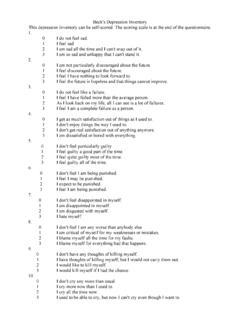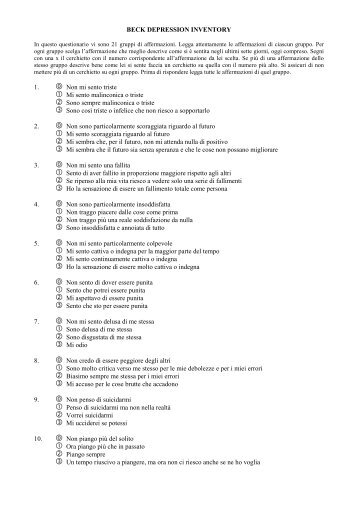


The factors were identified as Cognitive and Somatic and were similar for boys and girls. Confirmatory factor analyses with adolescent psychiatric inpatients (Osman et al., 2004) identified a 2-factor solution as the most parsimonious and interpretable.BDI-II scores are correlated with scores on the Reynolds Adolescent Depression Scale, the Beck Hopelessness Scale, the Beck Anxiety Inventory, the MMPI-A, and the Suicidal Behaviors Questionnaire-Revised and BDI-II scores discriminate between adolescents who do and do not meet DSM-IV criteria for a major depressive disorder (Krefetz et al., 2002 Kumar et al., 2002).Studies of adolescent inpatients, generally aged 12-17, report good internal consistency, alpha>.90 for the total scale and >.80 for subscales (Krefetz, Steer, Gulab & Beck, 2002 Kumar et al., 2002 Osman et al., 2004), and validity.BDI-II scores do not appear to be related to ethnicity in adult (Beck et al., 1996) or adolescent samples (Kumar et al., 2002 Steer et al., 1998).A number of studies report that females score significantly higher than males do on the BDI in adult (Beck, Steer, & Brown, 1996) and adolescent populations (Kumar, Steer, Teitelman, & Villacis, 2002 Osman, Kopper, Guttierez, Barrios, & Bagge, 2004 Steer, Kumar, Ranieri, & Beck, 1998).They also interpreted their findings as suggesting that the CES-D may be more effective in non-clinical populations. The authors suggested that the measures not be used interchangeably since they may be assessing different aspects of depression.

The authors suggested that the measures assess different underlying aspects of the construct of depression, with the CES-D assessing more of an affective component and the BDI assessing more of a cognitive component. One study involving a confirmatory factor analysis of the CES-D and the original BDI, failed to validate a single-factor model (Skorikov & Vandervoort, 2003). Analyses of adolescents have identified different but related factor solutions (see below). Analyses with adult inpatients have identified a single hierarchical depression factor (Cole, Grossman, Prillman, & Hunsaker, 2003). Factor analysis of the BDI-II has generally identified a 2-factor structure in adult outpatient and non-clinical samples, measuring cognitive-affective and somatic depressive symptoms (Dozois, Dobson, & Ahnberg, 1998 Storch, Roberti, & Roth, 2004).It has also been found to be sensitive to change with treatment, including in randomized trials with individuals who have experienced a trauma (Bryant, Moulds, Guthrie & Nixon, 2005) and those diagnosed PTSD (Ehlers et al., 2005).The BDI-II discriminates depressed from non-depressed patients (Beck, Steer, & Brown, 1996 Sprinkle et al., 1992).In adults, the BDI-II has been found to correlate with multiple measures of depression including the Center for Epidemiological Studies of Depression Scale (CES-D), Zung Self-Rating Depression Scale, the Beck Hopelessness Scale, and the Revised Hamilton Psychiatric Rating Scale for Depression (Beck, Steer, & Brown, 1996). Numerous studies have established the reliability and validity of the BDI-II in different populations and cultures.Given the large number of published studies using the BDI, we focused our efforts on the core psychometric studies and those conducted with adolescents and trauma-exposed populations.


 0 kommentar(er)
0 kommentar(er)
